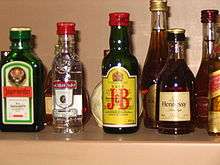Basi
Basi is a fermented alcoholic beverage made from sugarcane produced in the Philippines and Guyana.
Philippines
Basi is the local beverage of Ilocos in northern Luzon in San Ildefonso where it has been consumed since before the Spanish conquest. In the Philippines, commercial basi is produced by first crushing sugarcane and extracting the juice. The juice is boiled in vats and then stored in earthen jars. Once the juice has cooled, flavorings made of ground glutinous rice and duhat (java plum) bark or other fruits or barks is added. The jars are then sealed with banana leaves and allowed to ferment for several years. The resulting drink is pale red in color. If fermented longer, it turns into suka or vinegar.
The 1807 Basi Revolt in Piddig, Ilocos Norte, occurred when the Philippines' Spanish rulers effectively banned private manufacture of the beverage. A Basi festival is held annually in Naguilian, La Union.
Basi Brands in the Philippines
Basi del Diablo Wines of the Salucop Group, Inc. started making basi in the year 1906, 99 years after the Basi Revolt. The light fermented sugarcane winemaker's most prominent product is the Ambaristo, named after the Basi Revolt hero Pedro Ambaristo.[1]
Nagguilian Basi is another basi brand in the northern part of the Philippines. It is produced in Naguilian, La Union.[2]
200th anniversary of the Basi Revolt On April 31, 2012, San Ildefonso, Ilocos Sur officials (Governor Deogracias Victor “DV” Savellano and Rep. Ronald Singson) commemorated the “basi revolt.” Recently, the Sangguniang Bayan of San Ildefonso approved a resolution declaring September 16 as a non-working holiday and named the old road in Gongogong as Ambaristo street in honor Pedro Ambaristo, leader of the Basi Revolt. Mayor Christian Purisima enrolled basi as their entry into the “One Town; One Product” (OTOP) program of Savellano.[3]
Guyana
Basi is produced by first cutting sugar cane into small pieces. The cane is then placed into a container with refined sugar, water, and yeast for a minimum of nine days. Finally, the beverage is strained and bottled.


